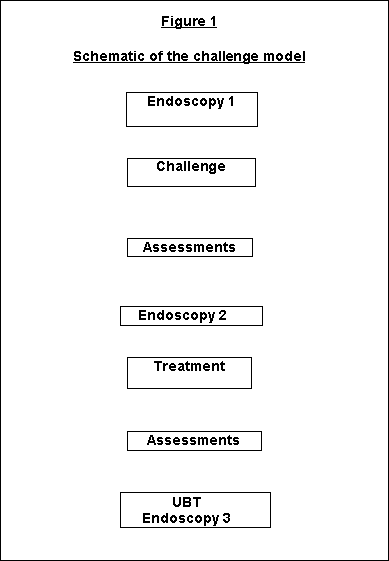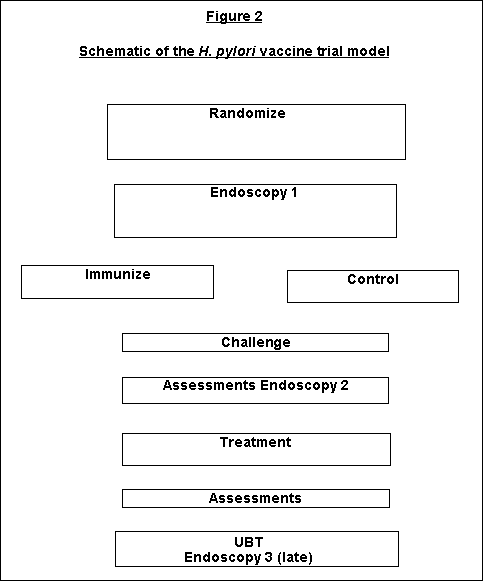NIAID Workshop:
Development of a Standardized Human Challenge Model for Helicobacter
pylori
November 30, 1999
Rockville, MD
Chairman: Martin Blaser, M.D.
Convener: Dennis Lang, Ph.D.
Conclusions
Questions Addressed at the Workshop
Conclusions
The results of the Workshop were presented and discussed at the NIAID
Advisory Council meeting on February 18, 2000. It was the recommendation
of the Council that the Institute should not pursue
the volunteer challenge model at this time. Several factors entered
into this decision including: 1) the lack of a compelling need for
vaccination in the U.S. where the rate of natural infection is decreasing,
2) the lack of a clear vaccination strategy for the U.S. (who would
be vaccinated?), 3) the fact that volunteers would be at risk of unsuccessful
antibiotic eradication of the challenge strain for an infection with
serious sequelae (ulcers and cancer) that may not be clinically diagnosed
for many years after the trial, 4) the availability of animal models,
which have not been thoroughly investigated as models for vaccine
efficacy, and 5) the ability to measure vaccine efficacy by more conventional
field trials. The possibility that infection with H. pylori
may be a factor in protection against Gastroesopageal Reflux Disease
(GERD) and esophageal cancer was also considered in the final recommendation.
It was acknowledged that in certain endemic regions of the world,
the benefit of an effective vaccine would be greater than in the U.S.
and that the recommendation could change in the future if new information
becomes available.
Top of Page
Questions Addressed at the Workshop
Are There Good Scientific and Clinical Reasons
to Develop a Standardized Human Challenge Model for H. pylori?
The following summarizes the group's consensus:
- Infection with H. pylori is a major cause of important
diseases such as peptic ulcer disease, gastric adenocarcinoma,
and primary gastric B-cell lymphoma.
- A vaccine against H. pylori could be extremely important
because there is a high probability that widespread use of current
antimicrobial therapies will not be feasible, especially in developing
countries, or even among the very poor in the US — in part
because of high cost, multiple side effects, the risk of reinfection
and of emerging drug resistance.
- Vaccines historically have been useful for disease prevention.
It is important to consider establishing models for H. pylori
vaccine development. The ultimate scientific goal would be field
trials of likely vaccine candidates, but the present state of
the knowledge does not provide a means for selecting such promising
candidates.
- As part of this effort and for other reasons, it is worthwhile
to understand the correlates of protection and safety, as well
as the pathogenesis of the disease.
- Animal models (with the possible exception of monkeys) are not
sufficient to address these fundamental issues.
- A human challenge model can be developed for the main purpose
of selecting optimal H. pylori vaccine candidates for
field trials. Studies can be designed to provide important information
on H. pylori immunity and pathogenesis.
Top of Page
Are There Ethical Ways to Conduct a Human
Challenge Model for H. pylori?
The crux of this question is whether there is a positive balance
between benefit and risk. The benefits of the challenge study to
the subject are essentially zero. However, such studies can provide
benefit to society at large. An H. pylori vaccine is potentially
beneficial for humankind since it could help prevent diseases important
in all parts of the world. Human challenge studies are a tool to
expedite and facilitate vaccine development by providing a means
for assessing vaccine efficacy in a small sample of subjects. Field
trials would require more subjects followed for longer periods of
time. However, field trials of other vaccine candidates have been
done without the benefit of preliminary challenge studies.
Conversely, a small but real risk of administering virulent H.
pylori to volunteers is the failure to eradicate the organism
with antibiotics, which carries a risk of eventual development of
serious disease. Additionally, there are the discomforts produced
by the induced disease and the procedures (three endoscopies, some
with biopsy, and antimicrobial therapy) that would form part of
the study protocol. Informed consent must describe adequately these
discomforts and risks. It is recommended that initial research protocols
include the systematic measurement of discomfort or suffering experienced
by volunteers in order to be able to assess the impact and safety
of the challenge model. This assessment must be considered in a
decision to proceed with additional studies using the model.
A summary of the risk-benefit analysis is as follows:
- Volunteer challenge studies can provide important benefits to
society.
- Three risks, which can be minimized by carefully designed trials,
distinguish H. pylori challenge trials from previous
challenge models:
- The potential for long-term sequelae
- The potential for transmission to community contacts
- The need for complex antibiotic therapy and its potential
to fail to eradicate the experimental infection.
- Discomforts from the induced infection or protocol procedures
are real and should be documented. Informed consent should include
adequate description of risks and discomforts.
- These risks can be reduced by a series of considerations related
to study subject (host) and study design issues specific to H.
pylori challenge. Relevant considerations raised at the meeting
include the following:
Host factors
- Previously healthy host
- No added risks for H. pylori-associated diseases
- Normal endoscopy and gastric histology prior to challenge
- Not pregnant or lactating or intending to become pregnant
in next 12 months
- No intolerance (including allergy) to the agents to be used
for treatment
Study design factors
- No substantial occupational or household contact of subject
with young children
- Informed consent that clearly defines risks and benefits
- The liability coverage available to the subject must be described
- Adequate follow-up to ensure eradication and significant improvement
in any challenge strain-induced gastric histopathologic changes
- Follow-up of household contacts for related symptoms
Top of Page
What are the Criteria for Strain Selection?
The group divided the criteria into those characteristics
that are necessary and those that are useful.
- Necessary Characteristics of the Cchallenge Strain
- Strain susceptibility to the first line and alternative antibiotics
to be used for eradication, and the forward mutation rate defined
- Freely available to all investigators in the field
- Sufficient characterization including DNA fingerprinting,
antigenic features, plasmid content
- Minimally passaged in vitro, passage history documented, and
inoculum produced under GLP or GMP
- The donor of the strain should have no communicable diseases
(e.g. HIV, Hepatitis B or C, syphilis) and should have no significant
gastric histopathology
- Useful Characteristics of the Challenge Strain
- The strain should be shown to be susceptible to antibiotics
in the donor; the donor should have been successfully eradicated
- The strain can colonize animals and cross-protect against
infections
A specific question that was vigorously debated concerns the genotype
of the challenge strain. H. pylori strains that are cagA+
are more highly associated with disease outcomes, and thus risk
to the participants in the trials. However, these are the most important
strains for a vaccine to prevent human colonization, and a vaccine
that prevented cagA- strains but not cagA+ strains
would not be considered very useful. In addition, there is evidence
that cagA+ strains are more susceptible to eradication
therapies than cagA- strains.
With these considerations in mind, the conferees recommend that
initial studies be done with a cagA- strain, to develop
a body of safety data and to refine the study design. A cagA+
strain also would be selected and used for a second round of challenge
studies with the knowledge that vaccine strategies must be successful
at preventing infection with cagA+ strains.
Top of Page
Which Clinical End-Points are Necessary to
Access Vaccine Efficacy?
Three different potential markers of vaccine efficacy were discussed:
- Symptoms. Symptoms such as dyspepsia
or abdominal pain are not specific for H. pylori, nor
sufficiently sensitive to reliably detect its presence. Although
volunteers would be monitored for symptoms, these would not be
an end-point.
- Eradication of H. pylori. The
prevention of persistent colonization after challenge would be
a standard means for assessing whether an H. pylori vaccine
was effective. An alternative proposed is "partial prevention"
in which colonization is not prevented, but bacterial density
is substantially lower than in the absence of vaccination. Such
an effect could conceivably reduce the risk of disease.
- Absence of gastritis. The presence of
H. pylori in the stomach nearly universally induces a
tissue response, called chronic gastritis. One end-point is the
histologic evaluation of gastric tissue for the presence of gastritis.
Top of Page
How Should Volunteers be Monitored During
the Trial?
If a challenge model was to be considered ethical, the conferees
would then suggest that the time course of experiments illustrated
in Figure 1 be used. Before being enrolled in the
study, each volunteer would be subjected to an esophago-gastro-duodenoscopy
with mucosal biopsies (histology and culture) to rule out current
H. pylori infection and presence of pathological lesions.
Following challenge, patients would be assessed for symptoms, immune
response, and colonization by H. pylori using C-13 urea
breath test. Just prior to initiation of triple therapy with a regimen
of antimicrobials recommended by the FDA (approximately 1 month
following challenge), endoscopy will be performed to assess histology,
H. pylori presence and quantity, and local immune responses.
Following treatment, the volunteers would be assessed with a reliable
non-invasive test such as the urea breath test and/or stool antigen
detection about one month after completion of therapy. In volunteers
whose tests are positive, there would be immediate endoscopy with
biopsy to determine histology and culturing of H. pylori
to determine susceptibility. Recovered H. pylori will also
be DNA fingerprinted (or gastric juice will be used for specific
PCR amplification and sequencing) to determine if the recovered
or persistent strain is of the same lineage as that used for infection.
After susceptibility of the isolate is determined, the volunteer
would be re-treated, and then reassessed.
For each volunteer whose tests are negative one month after treatment,
a late evaluation of status is planned. A late endoscopy is planned
at least 6 months after therapy to ensure eradication of the organism
and restoration of the gastric mucosa to normal.
The type of schema used in H. pylori challenge models
could be expanded for use in vaccine trial models (Figure
2). From the time of challenge, the conduct of the vaccine trial
would closely parallel or be identical to the challenge model. The
difference is that after the first endoscopy, the volunteers would
be randomized to immunization and control arms. Following the immunization
schedule, the challenge then would be given, as above.
Top of Page

Top of Page
